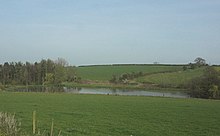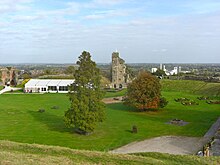Tutbury Castle
Tutbury Castle is a ruined castle in the village of Tutbury in the English county of Staffordshire . In the castle z. B. Eleanor of Aquitaine and also Maria Stuart , who was a prisoner. Today the ruin belongs to the Duchy of Lancaster , is a Scheduled Monument and English Heritage has listed it as a First Grade Historic Building.
Early history
Tutbury Castle became the headquarters of Henry de Ferrers and was the center of the Harde Appletree , which also included Duffield Frith . Together with his wife Bertha , De Ferrers endowed Tutbury Priory with two manors around 1080 . It seems that Tutbury Abbey was then a branch of the Norman Abbey of St. Pierre-sur-Dives .
1264, after the rebellion of de Robert Ferrers, 6th Earl of Derby , was the castle by the troops of Edward I destroyed. In 1269, after another rebellion, the lands were given to Edmund Crouchback, 1st Earl of Lancaster , and have remained with the Duchy of Lancaster ever since.
With the exception of the 12th century chapel , the ruins date from the 14th and 15th centuries when the castle was rebuilt.
In 1999, Lesley Smith became curator of the castle, which it leased from the Duchy of Lancaster.
Mary Queen of Scots at Tutbury Castle
In June 1568 Mary Queen of Scots was at Carlisle Castle after her flight from Scotland as a result of her defeat at the Battle of Longside , and the English Council of State decided to place her at either Nottingham Castle , Fotheringhay Castle or Tutbury Castle, allowing her further from and from the Scottish border Yorkshire was away. In January 1569 they brought the Scottish queen of Bolton Castle from first to Ripon , near which she spent one night and then to Wetherby , where a night with John Vavasour on Hazlewood Castle spent and then continue on Pontefract Castle , by Rotherham , after Chesterfield and Wingfield Manor . George Talbot, 6th Earl of Shrewsbury , was given detailed instructions on guarding Mary Queen of Scots, which allowed him to house her in Sheffield from time to time , whichever she preferred. He was also told what to say about her political situation.

Paintings, furniture and bedding were sent from the royal cloakroom in the Tower of London to decorate Tutbury Castle, but because of the delays caused by inclement weather, Bess of Hardwick was asked to send their things from Sheffield. So the Earl's house in Sheffield was practically empty and Mary Queen of Scots had to go to Tutbury Castle. She arrived there on February 4, 1569. She noticed that the castle was like a hunting lodge, with its enclosure on a small hill reminiscent of the Bois de Vincennes , and complained about the dampness, the wet plaster and the ill-fitting, drafty windows and doors. The British Library has a sketch of its premises at Tutbury Castle.
In March the Earl of Shrewsbury described Mary Stuart sitting with Bess, Countess of Shrewsbury, along with Lady Livingston and Mary Seaton in the Countess' bedroom at Tutbury Castle, working on embroidery. In April she moved to Wingfield Manor. Mary Queen of Scots was brought back to Tutbury Castle in September with increased guard and reduced budget. In November 1569, after the Catholic Rising of the North, she was quickly taken south to Coventry , where she was housed in an inn. On Christmas Eve, Queen Elizabeth sent instructions to return her to Tutbury Castle. The "pauvre prisonnière" (English: poor prisoner), as she described herself, was back on January 2, 1570 at Tutbury Castle. In May 1570, Mary Queen of Scots was sent to Chatsworth House .
In January 1585 she came back to Tutbury Castle via Wingfield Manor. On the way there she spent a night in Derby at the house of the widowed Mrs. Beaumont . Her guards, Ralph Sadler and John Somer , were instructed to provide sufficient hangings for Mary Queen of Scots bedroom. The hangings brought from Lord Paget's nearby house in Burton-upon-Trent and Beaudesert Hall were unsatisfactory. The queen's bedroom was in the upper part of an apartment (directly under the roof) that was built against the castle walls. This room was made of wood and had no windows through the castle wall; its two windows looked out onto the courtyard.
Mary Stuart also had a pool table. Ralph Sadler sometimes took her with him on a falcon hunt on the River Dove , only three miles from the castle, with 40 or 50 mounted men on guard. Elizabeth I disapproved of this practice and forbade it. On April 19, 1585, Mary Queen of Scots was placed under the guard of Amyas Paulet , who removed her state cloth from the room where he ate and prevented Mary's servants from using the perimeter wall near the gate. Paulet also curtailed their community service activities and disarmed their Scottish servants, many of whom had guns.
In July, Mary Queen of Scots was allowed to hunt deer with her greyhound in Stockley Park near Anslow . In August, Maria was afraid of moving temporarily to another house so that her living quarters could be swept and cleaned. Maria stated that the Earl of Shrewsbury followed his routine. But Lord Paget's nearby houses and the home of Mr. Henry Cavendish (son of courtier William Cavendish ) in Doveridge were not suited to accommodate all of their servants. Paulet considered having her apartment modified or letting the Queen use a different part of the part of the castle that he was using. The security aspects of this other apartment Mary Stuart stayed in in 1569 were difficult. It had two bedrooms eight meters above ground with windows looking over the moat towards the village of Tutbury. The windows and a "House of Office", a latrine, could have made an escape possible. On Christmas Eve 1585, she finally moved to Chartley Castle .
Ghosts
Among the ghosts believed to have been seen in the castle ruins are that of a soldier on the ramparts, a white woman in a window in the tower and Maria Stuart. A number of visitors to the royal bedchamber stated that they had been overcome by faintness; the room was then closed to the public for some time, but has since been reopened. There are both private and public ghost hunts in the castle ruins .
Individual evidence
- ↑ Marios Costambeys: Ferrers, Henry de (d. 1093x1 100) in Oxford Dictionary of National Biography . Oxford University Press, Oxford 2004. Online edition May 2007.
- ↑ JR Maddicott: Ferrers, Robert de, sixth earl of Derby (c. 1239-1279) in Oxford Dictionary of National Biography . Oxford University Press, Oxford 2004.
- ^ Joseph Bain (editor): Calendar State Papers Scotland . Volume 2 (1900), pp. 438-439, 543-544, 605.
- ^ Calendar State Papers Scotland . Volume 2 (1900). Pp. 606-607, 609-610, 612-614, 615-617.
- ^ Charles Mackie: Castles, Palaces & Prisons of Mary, Queen of Scots . 1850. pp. 427-428. Retrieved October 28, 2016.
- ^ Mary Queen of Scots Manuscript On Loan . British Library. August 24, 2013 . Retrieved October 28, 2016.
- ^ Calendar State Papers Scotland . Volume 2 (1900). Pp. 632-633.
- ^ Antonia Fraser: Mary, Queen of Scots . Wiedenfield, London 1969. pp. 409-414.
- ^ Mary, Queen of Scots: England: Calendar State Papers Scotland . Volume 3 (1903). Pp. 17, 21, 34, 36, 40-41. Retrieved October 28, 2016.
- ↑ HMC: 12th Report & Appendix, part 4, Duke of Rutland . Badn 1 (1888). P. 171. Ralph Sadler to John Manners.
- ^ Calendar State Papers Scotland . Volume 3 (1903). Pp. 555-558, 583.
- ↑ Arthur Clifford, Arthur (Editor): Sadler State Papers . Volume 2 (1809). Pp. 505-507, 511.
- ↑ Arthur Clifford, Arthur (Editor): Sadler State Papers . Volume 2 (1809). Pp. 538, 540.
- ^ John Morris (editor): Letter books of Amias Paulet . (1874). Pp. 11-12, 14, 39, 47, 53-54, 61, 63-64, 72-74. Retrieved October 28, 2016.
- ^ John Morris (editor): Letter books of Amias Paulet . (1874). Pp. 90-91, 105-106. Retrieved October 28, 2016.
- ^ Antonia Fraser: Mary, Queen of Scots . Wiedenfield, London 1969. pp. 419, 422, 474, 477, 479.
- ^ Haunted Happenings : Tutbury Castle.
Web links
Coordinates: 52 ° 51 '34.1 " N , 1 ° 41' 26.1" W.

